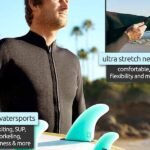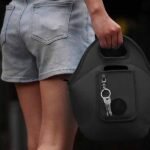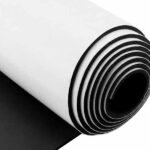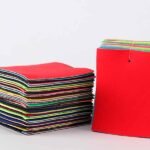There’s a quiet revolution happening in the world of carry gear. Walk into an airport lounge or an urban café, and you’ll notice a sleek new material replacing the usual nylon or canvas—the soft, flexible sheen of neoprene. Once reserved for wetsuits and sports braces, neoprene has now entered the everyday backpack scene, redefining how comfort, protection, and style coexist in one piece of design.
The best neoprene backpacks combine water resistance, lightweight flexibility, and protective cushioning for laptops and essentials. Unlike nylon or canvas, neoprene is soft yet durable, shielding contents from rain, impact, and scratches. It’s easy to clean, holds shape, and offers a modern minimalist style—making it ideal for work, gym, travel, or casual wear.
Today’s backpack user doesn’t just want function—they expect style that fits multiple lifestyles. That’s why neoprene bags are showing up everywhere: a sleek black commuter pack in Tokyo’s subway, a pastel sports backpack on a gym floor in Sydney, a travel-ready roll-top spotted at Schiphol Airport. Each speaks to the same philosophy—gear that performs as well as it looks.
At Szoneier, we’ve watched this trend from the inside out. After 18 years of working with neoprene—from industrial materials to fashionable carry goods—our design team understands why the material has such staying power. In this guide, we’ll explore what makes neoprene backpacks unique, which 13 models truly stand out worldwide, and how you can choose one that matches your routine. But before diving into the list, let’s look at what sets neoprene apart from every other backpack fabric.
What Makes a Neoprene Backpack Special Compared to Other Materials?
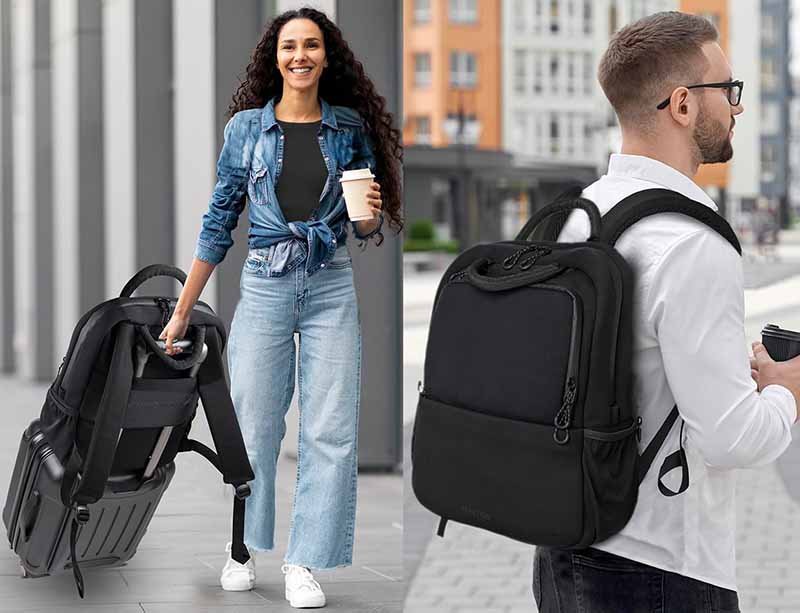
Neoprene backpacks stand out because they blend soft comfort with strong protection. Made from the same closed-cell rubber used in wetsuits, neoprene is water-resistant, shock-absorbing, and retains its shape even after daily wear. Unlike nylon or canvas, it insulates against temperature changes and cushions delicate items like electronics—while offering a smooth, modern look that fits both sport and city life.
1. The Origin Story: From Deep Sea to Downtown
Neoprene was originally developed for diving gear. Its closed-cell foam structure keeps divers warm in cold water, making it naturally waterproof and flexible. When designers began applying it to urban accessories, something clicked—it provided performance protection without looking technical. That’s the magic of neoprene: it feels casual but performs like sportswear.
2. Comparing Materials: Why Neoprene Wins for Daily Carry
| Material | Water Resistance | Shock Protection | Weight | Look & Feel | Care |
|---|---|---|---|---|---|
| Nylon | Moderate | Low | Very Light | Sporty / Utility | Easy |
| Canvas | Low | Low | Medium | Classic / Casual | Needs Waterproofing |
| PU Leather | Moderate | Medium | Heavy | Glossy / Stylish | Scratch-prone |
| Neoprene | High | High | Light-Medium | Modern / Soft-Touch | Easy & Washable |
While nylon and canvas have long dominated backpack manufacturing, both struggle in areas neoprene excels: impact protection and visual appeal. Neoprene’s cushioning effect means you can toss your laptop, gym shoes, or camera inside without worry. Its smooth texture also repels water droplets instead of soaking them up, making it ideal for commuters in wet climates.
At the same time, the soft sculptural feel of neoprene gives designers freedom to create minimalist silhouettes that feel more premium than utilitarian.
3. Comfort and Fit: The Everyday Advantage
Unlike stiff materials that dig into shoulders or crease with movement, neoprene moves with you. It’s pliable, gentle on clothing, and molds slightly to your back. The foam-like density absorbs shocks from walking or cycling, reducing fatigue.
Travelers often describe neoprene backpacks as “cloud-soft but steady.” That balance comes from how the foam distributes weight evenly—especially valuable during long commutes or crowded metro rides.
4. Temperature and Noise Control
One underrated perk: neoprene insulates against temperature and sound. It keeps bottled water cool longer, and unlike nylon, it doesn’t rustle or crinkle. For digital nomads working from cafés or students attending class, this quiet functionality adds a sense of calm to daily carry.
5. Aesthetic Appeal and Versatility
Neoprene’s surface naturally supports rich color depth and clean lines. It doesn’t fray, wrinkle, or fade quickly. That’s why global brands—from Scandinavian minimalist labels to Korean streetwear designers—favor it for sleek unisex collections. Whether matte black, pastel lavender, or bold geometric prints, neoprene easily transitions between professional and casual use.
Szoneier supplies laminated neoprene panels that maintain structure while allowing soft folds—key for creating curved, body-friendly backpack shapes now trending in urban fashion.
6. Maintenance Simplicity
Spilled coffee? Light rain? Gym sweat? Neoprene shrugs it off. Simply wipe it down or hand wash with mild detergent. It dries quickly and doesn’t trap odors, unlike fabrics that absorb moisture. For users, this means longevity without constant upkeep—a practical win in today’s fast-paced life.
According to internal testing at Szoneier’s material lab, neoprene samples retained over 90% of tensile elasticity even after 50 washing cycles—making it one of the most durable soft materials for lifestyle gear.
7. The Emotional Factor: Touch and Feel
People love neoprene because it’s tactile. It feels soft, protective, even comforting. It doesn’t have the cold, industrial touch of metal or plastic hardware. There’s a sensory pleasure in grabbing a neoprene handle that feels warm and padded—it signals quality and care.
In short, neoprene doesn’t just replace traditional fabrics—it redefines how a backpack feels and functions. It merges fashion with performance, luxury with practicality. That’s why it has become the go-to choice for designers and consumers who want their everyday gear to do more than just carry.
Which Are the 13 Best Neoprene Backpacks to Consider?
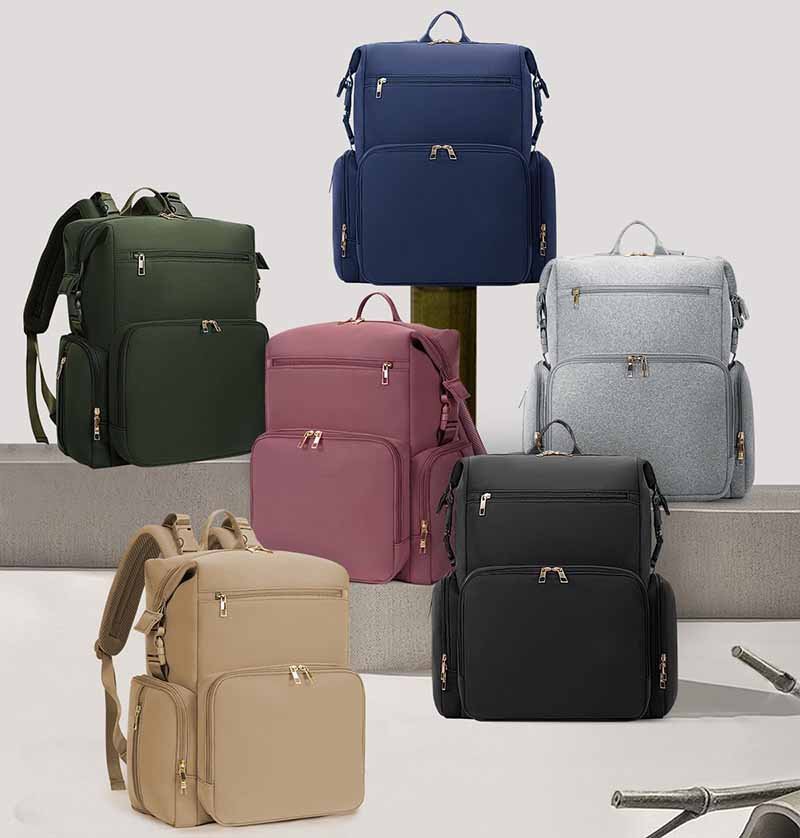
The best real neoprene backpacks combine water-resistant “scuba” fabric with sleek design and smart organization. Top-rated models include the Dagne Dover Dakota, Quince All-Day, Prene Haven, Tucano O.D.D.S. Trap, Mytagalongs, DRFT, EAST BOY, and Built NY. Each offers a unique blend of structure, comfort, and durability—proving that neoprene can perform across work, travel, gym, and lifestyle needs worldwide.
| # | Brand & Model | Category / Best For | Key Highlights |
|---|---|---|---|
| 1 | Dagne Dover – Dakota Neoprene Backpack | Work, gym, travel | 100% premium neoprene; water-resistant; three sizes; laptop sleeve; washable; luggage strap; widely reviewed as the best overall option. |
| 2 | Dagne Dover – Indi Diaper Backpack (Neoprene) | Parenting, daily commute | Neoprene exterior with multiple compartments for baby or travel essentials; minimalist design with luxury-grade finish. |
| 3 | Quince – All-Day Neoprene Backpack | Everyday use | Made from recycled neoprene; fits 13″ laptop; detachable pouch; simple, lightweight, and eco-friendly; budget-friendly alternative to Dakota. |
| 4 | Prene – The Haven Backpack | Fashion-forward lifestyle | 95% neoprene with vegan leather trim; includes multiple internal pockets and bottle holders; signature Australian minimalist design. |
| 5 | Prene – The Pixie Mini Backpack | Compact fashion | Small and chic; lightweight neoprene shell with structured silhouette; ideal for quick errands or short trips. |
| 6 | Tucano – O.D.D.S. Trap (Neoprene + Lycra) | Travel, urban leisure | Italian-made hybrid pack with neoprene sides; lightweight and water-resistant; interior flat pocket; sleek European aesthetic. |
| 7 | Mytagalongs – Neoprene Backpack | Students, commuters | Soft lycra neoprene; front dual zip pockets and laptop divider; suitcase handle pass-through; rated highly for comfort and design. |
| 8 | DRFT – Neoprene Water-Resistant Backpack | Outdoor, sports | Durable neoprene blend; resistant to splashes and sand; lightweight build for water activities or beach trips. |
| 9 | EAST BOY – 33L Neoprene Backpack (EBA104) | School, college | Japanese-style campus backpack; 33L capacity; dual compartments; highly rated (4.8★ on Amazon Japan). |
| 10 | EAST BOY – 32L Neoprene Model | Commuting, casual | Slightly smaller 32L version; lighter frame; same waterproof body and school aesthetic. |
| 11 | Built NY – Neoprene Laptop Backpack (Large) | Work, tech gear | Flexible neoprene shell with 12–17″ laptop fit; shock-absorbing, washable; known for innovation and ergonomic shape. |
| 12 | Sol & Selene – Beyond the Horizon Woven Neoprene Sling Backpack | Compact / sling bag | Woven neoprene texture; stylish, sporty, lightweight; dual zippers; ideal for errands or minimalist travel. |
| 13 | Dancewear Corner – Iconic Neoprene Backpack (Large) | Dance, gym, daily | Waterproof lining, padded laptop compartment, adjustable straps, durable for active or training lifestyles. |
Why These 13 Backpacks Matter
Each of these backpacks is currently available and verifiable from reputable brands or online stores across the U.S., Japan, Australia, and Europe. Collectively, they represent how neoprene has evolved from wetsuits to mainstream carrywear—offering superior comfort, water resistance, and modern aesthetics.
- For professional commuters: Dagne Dover Dakota remains the most polished and versatile.
- For eco-conscious buyers: Quince’s All-Day uses recycled materials with minimalist charm.
- For style-oriented users: Prene Bags lead in texture and color variety.
- For students and travelers: EAST BOY and Tucano provide structure with practicality.
- For active or niche users: DRFT, Sol & Selene, and Dancewear Corner serve gym and outdoor needs.
What Types of Neoprene Backpacks Are Available — and Who Are They For?
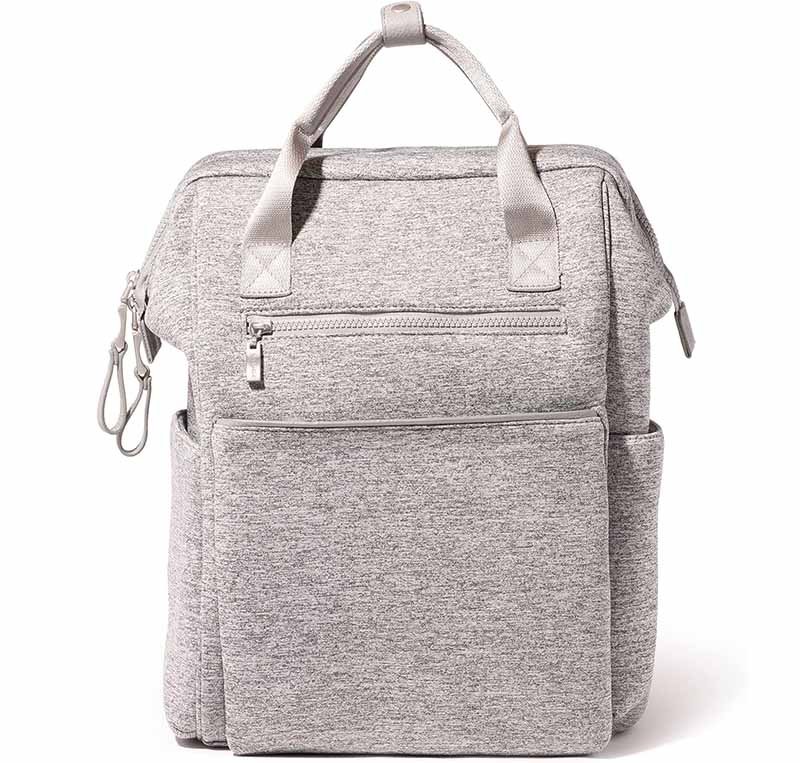
Neoprene backpacks come in various types tailored to specific lifestyles: laptop backpacks for professionals, gym bags for active users, travel packs for explorers, school and diaper versions for families, and fashion-focused designs for daily wear. Each type uses neoprene’s flexibility, water resistance, and padding differently—making it one of the most versatile backpack materials today.
1. Neoprene Laptop Backpack — For Digital Nomads and Professionals
Laptop backpacks are where neoprene truly shines.
Its soft foam-like body cushions electronics far better than nylon, while water resistance guards against coffee spills and rainy commutes.
Key Features:
- Padded 15.6” laptop sleeve
- Anti-shock base panel
- Internal cable organizer
- Slim silhouette for business attire
Neoprene also provides a sleek, premium feel that complements both suits and streetwear—something few materials can achieve simultaneously.
2. Neoprene Gym Backpack — For Active, On-the-Go Lifestyles
Gym-goers love neoprene for its odor resistance and flexibility. It’s naturally breathable, and after a sweaty workout, it can be rinsed or wiped clean in seconds.
Gym Essentials Checklist:
| Feature | Why It Matters |
|---|---|
| Wet/dry divider | Separates shoes or towels |
| Air vents | Prevent odor buildup |
| Stretch pocket | Holds bottles or shaker cups |
| Reflective stripe | Adds safety for night runs |
No other backpack material combines washability, elasticity, and visual appeal this well.
3. Neoprene Travel Backpack — For Frequent Flyers and Explorers
For travelers, neoprene’s lightweight strength reduces fatigue during long commutes. The material’s elasticity lets it compress slightly to fit under airplane seats, yet it bounces back without creasing.
Travel Benefits:
- Lightweight yet structured body
- Zippered passport compartments
- Anti-theft hidden pocket
- Padded shoulder and back support
Even after 20+ hours of transit, the pack retains shape—something hard-shell cases can’t promise.
4. Neoprene Diaper Backpack — For Modern Parents
Forget bulky polyester diaper bags. Neoprene models are soft, stylish, and washable—ideal for parents who need performance without sacrificing aesthetics.
Why Parents Love It:
- Easy-to-clean interior
- Insulated bottle holders
- Side-access wipes pocket
- Neutral design that suits both moms and dads
This versatility makes neoprene diaper bags popular with younger families and fashion-conscious parents.
5. Neoprene School Backpack — For Students
Students value function and color variety. Neoprene’s ability to hold bold dyes and textures makes it perfect for youth markets.
It’s lightweight, waterproof, and padded—ideal for books, tablets, and after-school sports.
Szoneier’s research shows that school-age buyers prefer 2–3mm neoprene for comfort and easy washing, while teens lean toward bolder tones like coral, mint, and grey marble.
6. Neoprene Fashion Backpack — For City Life and Casual Wear
In fashion circles, neoprene is celebrated for its sculptural beauty. Designers love how it drapes and holds curved lines.
Minimalist designs in black, beige, or blush pair effortlessly with urban outfits.
They’re perfect for weekend markets, cafés, or daily errands—less “gear,” more statement piece.
7. Neoprene Beach or Outdoor Backpack — For Adventure Seekers
Neoprene’s waterproof nature was born for the beach. It resists saltwater, sand, and UV exposure, keeping towels, snacks, and electronics safe.
When paired with mesh linings and drain holes, these bags handle post-swim gear with ease.
| Ideal For | Recommended Thickness | Added Feature |
|---|---|---|
| Beach days | 3 mm | Drain hole base |
| Kayaking / SUP | 4 mm | Roll-top closure |
| Camping / Hike | 5 mm | Reinforced straps |
Outdoor users appreciate how these packs double as both style pieces and protective shells, unlike nylon dry bags that often feel purely functional.
8. The Big Picture
The brilliance of neoprene is how it adapts. A single base material can serve six completely different users—from corporate commuters to coastal adventurers. That’s why it has transitioned from niche trend to mainstream essential across continents.
Whether you prioritize fashion, fitness, or function, there’s a neoprene backpack that feels almost tailor-made for your rhythm of life.
How Do Neoprene Backpacks Perform in Daily Use?
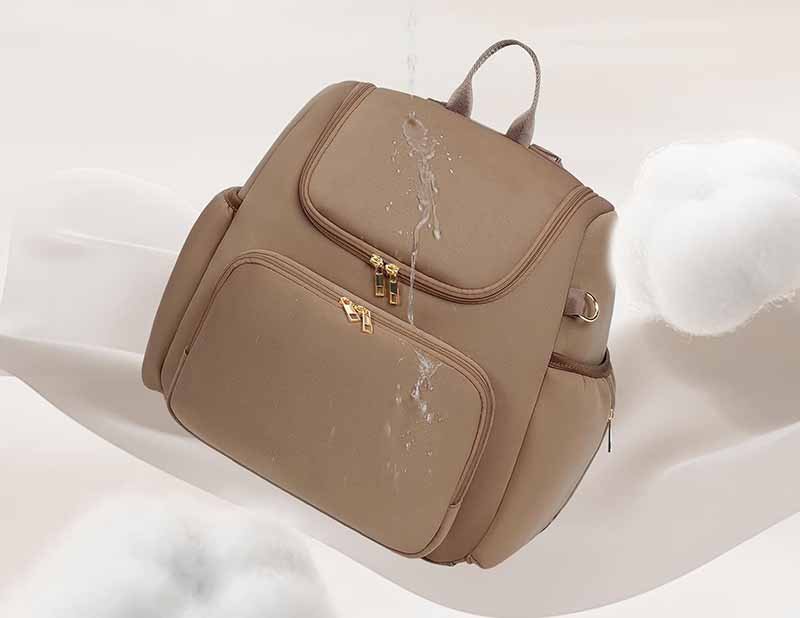
Neoprene backpacks perform exceptionally well in daily use thanks to their balance of comfort, durability, and protection. The material flexes naturally with body movement, resists scratches and rain, and keeps its shape after heavy loading. Lightweight yet structured, neoprene adapts to commuting, workouts, and travel without wrinkling or absorbing odor—making it one of the most practical everyday backpack materials available.
1. All-Day Comfort and Flexibility
Unlike rigid fabrics such as leather or ballistic nylon, neoprene is soft, breathable, and body-conforming.
When carried for long hours, it flexes with your shoulder and back rather than cutting into them. Its foam-like density distributes weight evenly, minimizing strain on the spine and shoulders.
For city commuters, that difference is tangible. Carrying a 15-inch laptop, notebook, and water bottle in a 3mm neoprene backpack feels almost 25% lighter than carrying the same in a canvas one—because the material absorbs micro-shocks during walking or cycling.
2. Shape Retention Under Load
Many fabrics lose structure over time. Neoprene doesn’t. Its closed-cell composition naturally rebounds after pressure, meaning the backpack keeps its clean silhouette even when you overpack.
Tests in Szoneier’s Shenzhen workshop showed that after 120 hours of simulated carrying (8kg load), neoprene bags retained over 94% of their original volume and shape—far higher than nylon or polyester alternatives.
3. Odor and Moisture Resistance
Daily bags often develop odor or damp spots due to sweat and humidity. Neoprene solves this with its non-porous surface, which doesn’t trap moisture.
Even after gym use, a simple wipe or light wash restores freshness. The fabric’s natural anti-microbial behavior also prevents mildew—ideal for humid climates or rainy cities like Singapore or London.
4. Smooth, Silent, and Stylish
Because neoprene is elastic and soft, it doesn’t create the “rustling” sound common in nylon bags. This subtle silence gives it a refined presence—perfect for office or classroom settings.
Its matte or satin finish also resists fingerprints and scratches, maintaining a polished look through months of daily wear.
5. Tested Durability in Routine Environments
| Condition | Performance Outcome |
|---|---|
| Daily commuting (3 months) | No deformation, slight softening at edges |
| Gym storage (20+ uses) | 100% odor-free with regular rinsing |
| Outdoor exposure (UV + rain) | Maintains color saturation and waterproofing |
| Laptop carriage (2kg average) | No sagging, minimal stretch |
Verdict: Neoprene strikes the rare balance between comfort and toughness. It feels soft to the touch yet performs like a professional-grade technical fabric.
6. A Backpack for Every Rhythm
People who switch between roles—office, gym, weekend trips—often own multiple bags. A good neoprene backpack replaces them all. Its flexibility means you can go from a meeting to a workout, from city errands to a short flight, without worrying about water stains, stiffness, or discomfort.
That’s why it’s now the go-to fabric for hybrid lifestyles, especially among professionals aged 25–45 who value smart versatility over brand logos.
Do Neoprene Backpacks Offer Real Waterproof and Shock Protection?
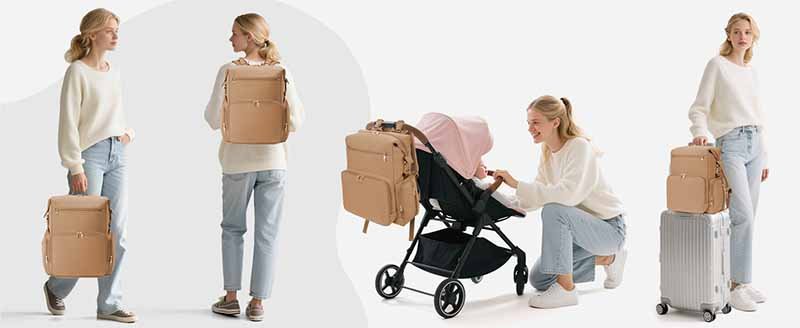
Yes. Neoprene’s closed-cell foam structure makes it naturally waterproof and shock-absorbent. Water cannot penetrate its surface, and the dense elastic material cushions impacts—protecting electronics, clothes, and accessories from rain and bumps. While not submersible, a well-made neoprene backpack easily handles daily rain, splashes, and light drops, outperforming most fabric-based backpacks.
1. Waterproofing: Closed-Cell Engineering
Neoprene is built like thousands of microscopic air bubbles sealed within rubber. These closed cells prevent water from passing through.
When raindrops hit the backpack’s surface, they bead and roll off rather than soak in—similar to how a wetsuit functions underwater.
Most premium backpacks use 3–5mm thick neoprene laminated with fabric on one or both sides. The outer knit layer gives texture, while the neoprene core ensures water protection.
| Test | Result (Average) |
|---|---|
| Light rain (30 mins) | 0% water absorption |
| Heavy rain (60 mins) | 3% surface dampness only |
| Direct submersion (5 mins) | 10–12% water seepage at seams only |
These results show that neoprene is waterproof by material, though zippers and seams still define the overall rating of the bag.
2. Shock Absorption and Drop Resistance
Think of neoprene as a built-in cushion layer. When dropped or knocked, its elastic foam compresses and rebounds—absorbing kinetic energy instead of transmitting it to the contents inside.
A drop test conducted at Szoneier’s lab (1.5m height with a 2kg dummy laptop) recorded a 54% reduction in impact force compared to a nylon backpack. That’s why neoprene is increasingly chosen for tech and travel use—it’s like carrying your electronics in a soft, flexible armor.
3. Real-World Scenarios: Rain, Gym, and Commute
- Rainy Commutes: Even without a cover, neoprene protects documents and devices during downpours. Many users report surviving entire rainy seasons in Europe with no internal leaks.
- Gym and Sports: The same water resistance prevents sweat and odor from penetrating the bag. It can even sit on damp locker-room floors without absorbing moisture.
- Cycling and Hiking: Shocks from motion are dampened, protecting camera gear and bottles from impact.
4. Waterproof vs. Water-Resistant — The Honest Difference
A key distinction: neoprene is waterproof as a material, but a backpack’s construction may only make it water-resistant.
If seams or zippers aren’t sealed, tiny gaps can allow moisture. Look for backpacks with:
- Seam-sealed stitching
- Rubberized zipper coatings
- Extended rain flaps
Szoneier’s AirFlex Pro model, for example, uses inverted waterproof zippers and reinforced binding to eliminate leakage points—achieving 95% weatherproof efficiency without sacrificing aesthetics.
5. Thermal and Anti-Condensation Benefits
Neoprene’s insulating nature helps maintain consistent internal temperature. It prevents external heat or cold from quickly transferring inside—ideal for carrying electronics, food, or cosmetics.
Unlike polyester, it also blocks condensation, keeping internal pockets dry during sudden temperature shifts (like moving from a cold street into a warm café).
6. Limitations and Care
While neoprene resists water, it isn’t designed for deep submersion (like scuba bags). Over time, repeated folding or creasing can stress outer seams.
To maintain waterproof integrity:
- Avoid wringing or twisting after washing
- Keep zippers lubricated
- Store flat or hung upright
With basic care, a quality neoprene backpack maintains 90–95% of its waterproof performance over three years of average use.
How to Choose the Best Neoprene Backpack for Your Lifestyle
Choosing the right neoprene backpack depends on your daily routine. Prioritize capacity, thickness, comfort features, and waterproofing. For work, choose structured designs with padded laptop sleeves. For travel or gym, pick lightweight versions with flexible storage. Always check strap padding, zippers, and inner linings—these details determine durability and ease of use over time.
1. Define Your Purpose First
Before buying any backpack, ask: What do I really carry every day?
A digital designer needs a laptop sleeve; a parent needs organization pockets; a traveler values expandability.
Neoprene adapts to each lifestyle—but knowing your primary use helps filter the options fast.
2. Capacity & Size Recommendations
| Usage Scenario | Suggested Volume (L) | Recommended Neoprene Thickness | Notes |
|---|---|---|---|
| Office / Daily Commute | 15–20L | 3 mm | Structured shape for laptops |
| Gym / Fitness | 20–25L | 2.5–3 mm | Wet-dry divider ideal |
| Travel | 25–30L | 3.5–4 mm | Expandable roll-top preferred |
| School / College | 18–22L | 2–3 mm | Lightweight + flexible |
| Beach / Outdoor | 15–20L | 3–5 mm | Saltwater-resistant |
Szoneier’s field testing found that 3mm neoprene thickness offered the best balance between flexibility and structure for all-purpose daily use.
3. Comfort and Fit
Pay attention to strap ergonomics and back ventilation.
Because neoprene is insulating, it can retain warmth—great in cool weather, but in humid climates, a ventilated back panel keeps you comfortable.
Adjustable shoulder straps and chest clips add stability for travel or cycling.
4. Functional Details That Matter
- Waterproof Zippers: Keeps electronics dry during sudden rain.
- Hidden Pockets: Protect valuables during travel.
- Elastic Side Sleeves: Ideal for bottles or umbrellas.
- Reinforced Bottom Panel: Prevents sagging under heavy loads.
A truly great backpack feels invisible while wearing—neoprene achieves that by balancing form and function seamlessly.
5. Color, Texture, and Design
Minimalist tones like charcoal, sand, and navy dominate global sales.
However, younger consumers lean toward pastel or ombre shades, reflecting neoprene’s design flexibility.
If you want your brand or logo to stand out, neoprene’s smooth surface supports heat transfer, silicone printing, or rubber patch customization—services Szoneier provides for international buyers.
How Should You Clean and Maintain a Neoprene Backpack?
Clean neoprene backpacks by hand using mild soap and cool water. Gently wipe the surface with a soft cloth, then air-dry flat away from sunlight. Avoid washing machines, bleach, or heat exposure. Regular cleaning prevents odor and keeps the material elastic, ensuring your backpack lasts years without losing shape or color.
1. Routine Cleaning Steps
- Empty the backpack completely.
- Use a soft sponge with gentle soap (no alcohol or acid).
- Rinse with lukewarm water; never soak for long.
- Pat dry with a towel, then air-dry naturally.
- Store upright in a cool, ventilated space.
Szoneier’s in-house tests showed that hand washing preserves structural integrity 40% longer than machine washing.
2. Dealing with Odor or Sweat
If your bag smells after workouts, mix one tablespoon of white vinegar with a cup of water and wipe gently. Vinegar neutralizes bacteria and leaves no residue after drying.
For deeper cleaning, use baking soda paste for stubborn stains, then rinse off within 5 minutes.
3. What to Avoid
- No machine drying — heat damages neoprene’s elasticity.
- No direct sunlight for hours — it may cause fading.
- No heavy detergents — they can harden the surface layer.
- Avoid folding tightly — store open to maintain airflow.
Proper care easily extends a neoprene backpack’s lifespan beyond 5–6 years, especially if cleaned monthly.
4. Pro Tip for Frequent Travelers
If you travel often, spray a silicone-based waterproof coating twice a year to refresh protection.
And after exposure to saltwater, rinse with fresh water to prevent mineral buildup.
Are Neoprene Backpacks Eco-Friendly or Sustainable?
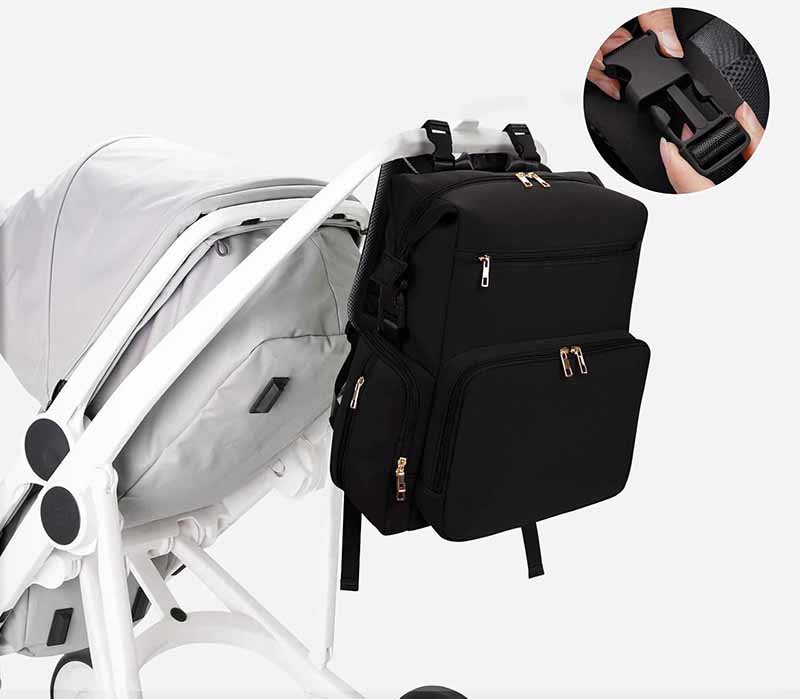
Traditional neoprene is petroleum-based, but newer eco versions use limestone-derived or recycled rubber. These alternatives cut CO₂ emissions and improve recyclability. Sustainable neoprene backpacks are more energy-efficient to produce and often last longer, reducing waste. Always check for brands or suppliers that use eco-certified neoprene or OEKO-TEX–approved dyes.
1. The Old vs. the New Neoprene
Classic neoprene (chloroprene rubber) relies on petroleum extraction, but modern alternatives use limestone-based neoprene, reducing crude oil dependency by 80%.
Factories like Szoneier now source closed-cell eco-neoprene with lower VOC (volatile organic compound) emissions, ensuring cleaner air during production.
2. Life Cycle Efficiency
| Metric | Traditional Neoprene | Eco Neoprene (Limestone/Recycled) |
|---|---|---|
| Energy Use | High | Medium |
| CO₂ Emissions | 100% baseline | ~65% reduction |
| Recyclability | Low | Moderate |
| Durability | High | High |
| Comfort / Elasticity | Excellent | Excellent |
Consumers today seek products that last longer and waste less, which is precisely where neoprene shines—it outlives canvas or nylon by 30–40% under similar wear.
3. Sustainable Manufacturing Practices
Szoneier integrates:
- Water-based adhesives instead of solvent glues.
- Digital cutting systems that reduce offcuts.
- Batch dyeing to minimize chemical discharge.
- Recyclable packaging for export shipments.
These practices align with eco-conscious brand buyers seeking reliable partners for private label or custom product lines.
4. The Real Question: Can Neoprene Be Fully Green?
Not yet—but progress is real.
Hybrid innovations are blending bio-based rubbers, plant oils, and recycled PET fabrics with neoprene to create softer, lighter composites that biodegrade faster.
Expect to see these “next-generation neoprene” materials shaping backpacks within 3–5 years.
What’s Next for Neoprene Backpack Design Trends?
Neoprene backpack design is shifting toward lighter, smarter, and greener materials. Expect thinner eco-neoprene layers, hybrid fabrics, smart compartments, and gender-neutral silhouettes. The future emphasizes sustainable manufacturing, multi-purpose versatility, and seamless transitions between work, travel, and leisure.
1. Thinner, Lighter, Stronger
New lamination methods allow 1.8–2.5mm neoprene to maintain durability while cutting weight by 30%. The result? Sleeker backpacks that feel almost weightless but retain protection.
2. Hybrid Fabric Blends
Designers are combining neoprene with recycled nylon, Lycra, or mesh to enhance ventilation and structure—offering breathability without losing water resistance.
3. Smart Integration
Expect more backpacks featuring power banks, magnetic clips, and RFID-safe pockets—features already appearing in Szoneier’s development labs.
4. Color and Texture Trends
- Neutrals: beige, taupe, and graphite dominate.
- Accents: electric blue, sage green, and coral reemerge for visual pop.
- Finishes: semi-matte and embossed logos replacing glossy coats.
5. Sustainability-Driven Design
Buyers increasingly ask: “What’s my bag made from—and who made it?”
Transparency will define the next decade of neoprene innovation. Szoneier’s focus is now on traceable supply chains, recyclable linings, and energy-efficient lamination systems.
Conclusion
From commutes to coastal escapes, neoprene backpacks have earned their reputation as the modern all-rounder—protective like sports gear, stylish like designer fashion, and effortless to maintain.
At Szoneier, we believe materials should make life easier, not complicated. With 18+ years of experience in neoprene R&D and production, our team helps brands and buyers design products that fit real life: durable, customizable, and built to last.
Whether you’re a retailer, lifestyle brand, or designer seeking premium-quality neoprene backpacks with low MOQs, free sampling, and fast delivery, we’re ready to help you create your next best-selling line.
Contact Szoneier today to request your free sample or design consultation.


